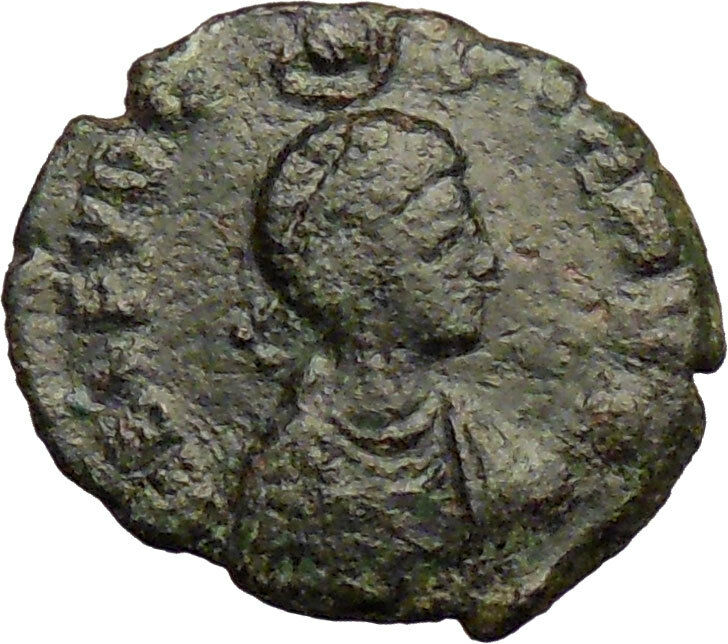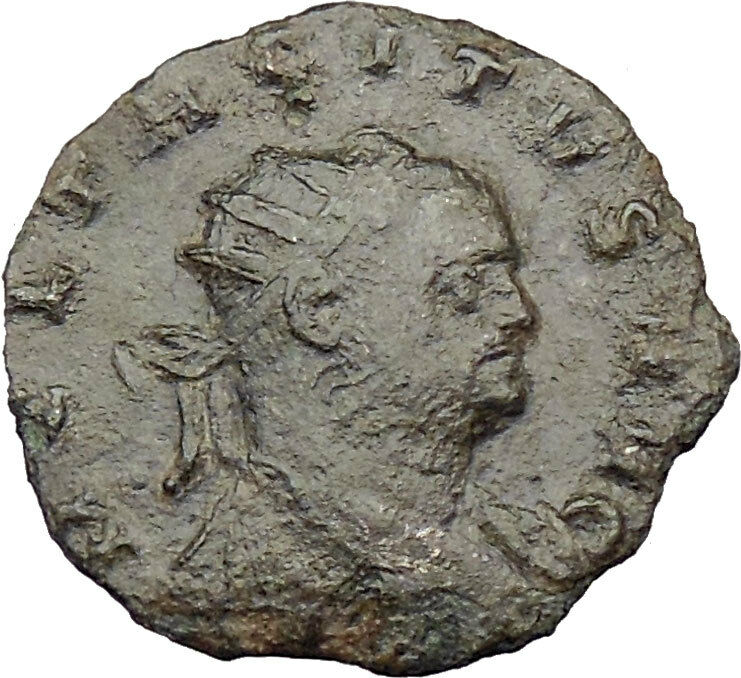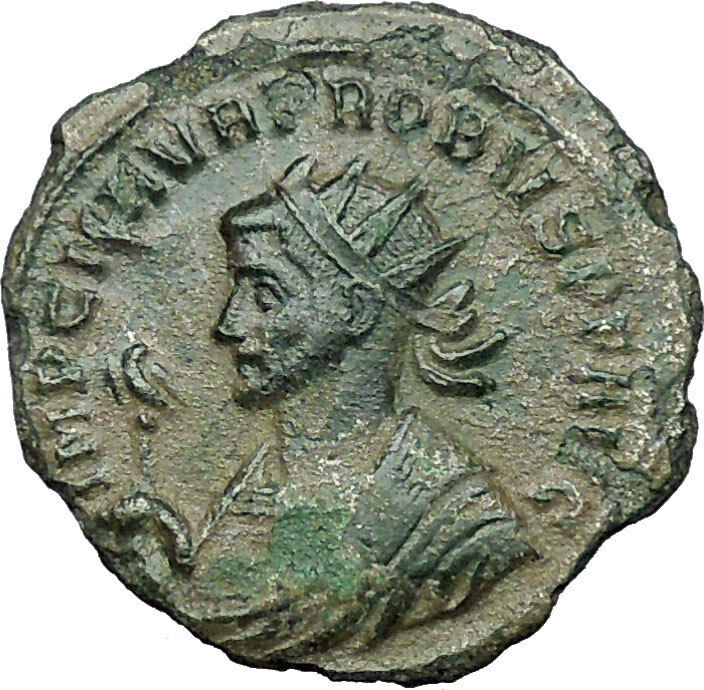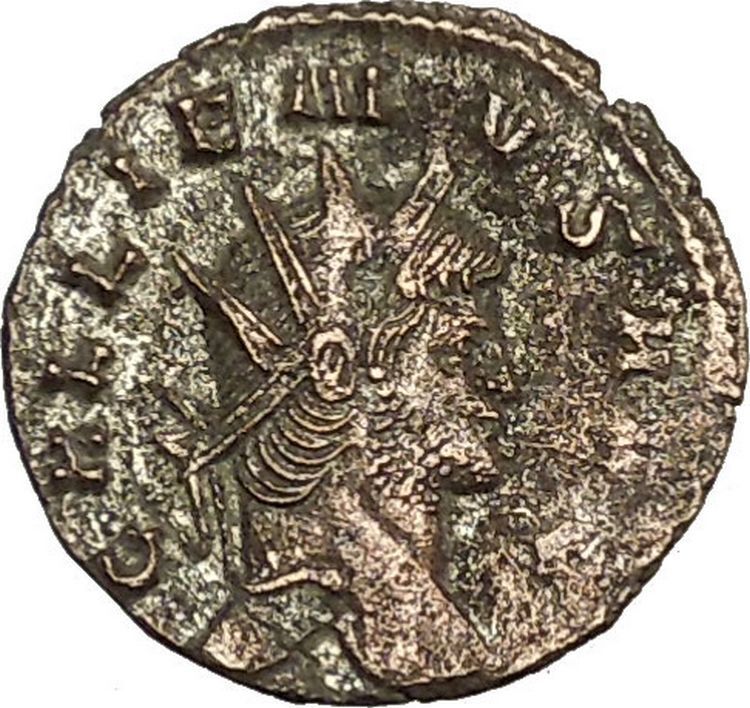|
Aurelian – Roman Emperor: 270-275 A.D. –
Bronze Antoninianus 21mm (2.71 grams) Struck circa 270-272 A.D.
Reference: RIC 192c
IMPCAVRELIANVSAVG – Radiate, draped and cuirassed bust right.
CONCORDIAMILI – Concordia standing left, holding standard in each hand;
officina P in right field.
You are bidding on the exact item pictured,
provided with a Certificate of Authenticity and Lifetime Guarantee of
Authenticity.
Standards

Roman military standards. The standards with discs, or signa
(first three on left) belong to centuriae of the
legion (the image does not show the heads of the standards – whether
spear-head or wreathed-palm). Note (second from right) the
legion’s
aquila
. The standard on the
extreme right probably portrays the
She-wolf
(lupa) which fed
Romulus
, the legendary founder of
Rome. (This was the emblem of
Legio VI Ferrata
, a legion then
based in
Judaea
, a detachment of which is
known to have fought in Dacia). Detail from Trajan’s Column, Rome

Modern reenactors parade with replicas of various legionary
standards. From left to right: signum (spear-head type), with
four discs; signum (wreathed-palm type), with six discs;
imago of ruling emperor; legionary aquila; vexillum
of commander (legatus) of
Legio XXX Ulpia Victrix
, with
embroidered name and emblem (Capricorn) of legion
Each tactical unit in the imperial army, from centuria upwards, had
its own standard. This consisted of a pole with a variety of adornments that was
borne by dedicated standard-bearers who normally held the rank of duplicarius.
Military standards had the practical use of communicating to unit members where
the main body of the unit was situated, so that they would not be separated, in
the same way that modern tour-group guides use umbrellas or flags. But military
standards were also invested with a mystical quality, representing the divine
spirit (genius) of the unit and were revered as such (soldiers frequently
prayed before their standards). The loss of a unit’s standard to the enemy was
considered a terrible stain on the unit’s honour, which could only be fully
expunged by its recovery.
The standard of a centuria was known as a signum, which was
borne by the unit’s signifer. It consisted of a pole topped by either an
open palm of a human hand or by a spear-head. The open palm, it has been
suggested, originated as a symbol of the
maniple
(manipulus = “handful”), the
smallest tactical unit in the
Roman army of the mid-Republic
. The poles were
adorned with two to six silver discs (the significance of which is uncertain).
In addition, the pole would be adorned by a variety of cross-pieces (including,
at bottom, a crescent-moon symbol and a tassel). The standard would also
normally sport a cross-bar with tassels.
The standard of a Praetorian cohort or an auxiliary cohort or ala was
known as a vexillum
or banner. This was a square flag,
normally red in colour, hanging from a crossbar on the top of the pole. Stitched
on the flag would be the name of the unit and/or an image of a god. An exemplar
found in Egypt bears an image of the goddess Victory on a red background. The
vexillum was borne by a vexillarius. A legionary detachment (vexillatio)
would also have its own vexillum. Finally, a vexillum
traditionally marked the commander’s position on the battlefield.[194]
The exception to the red colour appears to have been the Praetorian Guard, whose
vexilla, similar to their clothing, favoured a blue background.
From the time of
Marius
(consul 107 BC), the standard of all
legions was the
aquila
(“eagle”). The pole was surmounted
by a sculpted eagle of solid gold, or at least gold-plated silver, carrying
thunderbolts in its claws (representing
Jupiter
, the highest Roman god. Otherwise the
pole was unadorned. No exemplar of a legionary eagle has ever been found
(doubtless because any found in later centuries were melted down for their gold
content).
The eagle was borne by the aquilifer, the legion’s most senior
standard-bearer. So important were legionary eagles as symbols of Roman military
prestige and power, that the imperial government would go to extraordinary
lengths to recover those captured by the enemy. This would include launching
full-scale invasions of the enemy’s territory, sometimes decades after the
eagles had been lost e.g. the expedition in 28 BC by
Marcus Licinius Crassus
against
Genucla
(Isaccea, near modern
Tulcea
, Rom., in the Danube delta region), a
fortress of the Getae
, to recover standards lost 33 years
earlier by
Gaius Antonius
, an earlier
proconsul
of
Macedonia
.
Or the campaigns of AD 14-17 to recover the three eagles lost by
Varus
in AD 6 in the
Teutoburg Forest
.
Under Augustus, it became the practice for legions to carry portraits (imagines)
of the ruling emperor and his immediate family members. An imago was
usually a bronze bust carried on top of a pole like a standard by an
imaginifer.
From around the time of Hadrian (r. 117-38), some auxiliary alae
adopted the dragon-standard (draco) commonly carried by Sarmatian cavalry
squadrons. This was a long cloth wind-sock attached to an ornate sculpture of an
open dragon’s mouth. When the bearer (draconarius) was galloping, it
would make a strong hissing-sound.
Decorations
The Roman army awarded a variety of individual decorations (dona) for
valour to its legionaries. Hasta pura was a miniature spear; phalerae
were large medal-like bronze or silver discs worn on the cuirass; armillae
were bracelets worn on the wrist; and
torques were worn round the neck, or on the cuirass. The highest
awards were the coronae (“crowns”), of which the most prestigious was the
corona civica, a crown made oak-leaves awarded for saving the life of a
fellow Roman citizen in battle. The most valuable award was the corona
muralis, a crown made of gold awarded to the first man to scale an enemy
rampart. This was awarded rarely, as such a man hardly ever survived.
There is no evidence that auxiliary common soldiers received individual
decorations like legionaries, although auxiliary officers did. Instead, the
whole regiment was honoured by a title reflecting the type of award e.g.
torquata (“awarded a torque”) or armillata (“awarded bracelets”).
Some regiments would, in the course of time, accumulate a long list of titles
and decorations e.g. cohors I Brittonum Ulpia torquata pia fidelis c.R..
In
Roman religion
, Concord (Latin:
Concordia, “harmony”) was the
goddess of agreement, understanding, and marital harmony. Her Greek version is
Harmonia
, and the Harmonians and some
Discordians
equate her with
Aneris
. Her opposite is Discordia (or the Greek
Eris
).The
cult of Concordia
Augusta
(“Majestic Harmony”) was of special importance to the
imperial household
. Dedicatory inscriptions to her, on behalf of emperors
and members of the imperial family, were common. The oldest
Temple of Concord
, built in
367 BC
by
Marcus Furius Camillus
, stood on the
Roman
Forum
. Other temples and shrines in Rome dedicated to Concordia were largely
geographically related to the main temple.
Lucius Domitius Aurelianus
(September
9, 214
or 215 –September or October 275), known in English as
Aurelian,
Roman
Emperorr
(270–275), was the second of several highly successful
“soldier-emperors” who helped the
Roman
Empire
regain its power during the latter part of the third century and the
beginning of the fourth.
During his reign, the Empire was reunited in its
entirety, following fifteen years of rebellion, the loss of two-thirds of its
territory to break-away empires (the
Palmyrene Empire
in the east and the
Gallic Empire
in the west) and devastating barbarian invasions. His
successes started the end of the empire’s
Crisis of the Third Century
.
//
Aurelian was an upwardly-mobile soldier who was eventually appointed
commander of the cavalry by Claudius II. With the aid of a sympathetic army he
revolted against the accession of Quintillus and a civil war was avoided when
the latter committed suicide following the growing popularity of his rival.
Aurelian was then hailed as emperor by the Senate and the rest of the legions
alike. His first mission was to strengthen the army by the introduction of the
strictest reforms and discipline as well as quelling the various uprisings that
had broken out over the last two decades. He thus spent the next five years
until cut down by his own Praetorian Guard at the height of his glory. It seems
Aurelian’s personal secretary, after being reprimanded by the emperor for
attempted extortion, felt an execution would follow. To guard against this
possibility, he concocted a story about Aurelian intending to execute his
personal guard and then rushed to share with them this manufactured evidence.
Naturally, afraid for their lives, they entered the emperor’s quarters and
effected a preemptive strike. Somehow or other it was soon afterward found out
that the formerly beloved emperor had no such motives and his secretary himself
was swiftly executed for treason. When news reached Rome of what had happened
Aurelian’s wife seems to have actually been left nominally in power while a new
emperor was selected, a period that may have lasted several months. Although
history is a little hazy in this matter, it would mark the first and only time a
Roman empress explicitly ruled the empire.
Rise to power
Aurelian was born in
Dacia ripensis
or
Sirmium
(now
Sremska Mitrovica
,
Serbia
),
to an obscure provincial family; his father was tenant to a senator named
Aurelius, who gave his name to the family.
Aurelian served as a general in several wars, and his success ultimately made
him the right-hand man and dux equitum (cavalry commander) of the army of
Emperor Gallienus
. In 268, his cavalry routed the powerful cavalry force of the
Goths
at the
Battle of Naissus
and broke the back of the most fearsome invasion of Roman
territory since Hannibal
. According to one source, Aurelian participated in the
assassination of Gallienus (268), and supported
Claudius II
for the purple.
Two years later, when Claudius died his brother
Quintillus
seized power with support of the Senate. With an act typical of the
Crisis of the Third Century
, the army refused to recognize the new emperor,
preferring to support one of its own commanders: Aurelian was proclaimed emperor
in September 270 by the
legions
in Sirmium. Aurelian defeated Quintillus’ troops, and was recognized emperor by
the Senate after Quintillus’ death. The claim that Aurelian was chosen by
Claudius on his death bed
can be dismissed as propaganda; later, probably in 272, Aurelian put his own
dies imperii the day of Claudius’ death, thus implicitly considering
Quintillus a
usurper
.
With his base of power secure, he now turned his attention to Rome’s greatest
problems — recovering the vast territories lost over the previous two decades,
and reforming the res publica.
Conqueror and reformer
In 248, Emperor
Philipp
had celebrated the millennium of the city of Rome with great and
expensive ceremonies and games, and the empire had given a tremendous proof of
self-confidence. In the following years, however, the empire had to face a huge
pressure from external enemies, while, at the same time, dangerous civil wars
threatened the empire from within, with a large number of usurpers weakening the
strength of the state. Also the economical substrate of the state, the
agriculture and the commerce, suffered from the disruption caused by the
instability. On top of this an epidemic swept through the Empire around 250,
greatly diminishing manpower both for the army and for agriculture. The end
result was that the empire could not endure the blow of the capture of Emperor
Valerian
in 260: the eastern provinces found their protectors in the rulers
of the city of Palmyra
, in
Syria
Palmyrene Empire
, a separate entity from the Roman Empire, successful
against the Persian threat; the western provinces, those facing the
limes
of the
Rhine
seceded,
forming a third, autonomous state within the territories of the Roman Empire,
which is now known as
Gallic Empire
; the emperor, in Rome, was occupied with the internal menaces
to his power and with the defence of
Italia
and the Balkans. This was the situation faced by Gallienus and
Claudius, and the problems Aurelian had to deal with at the beginning of his
rule.
Reunification of the empire
The first actions of the new emperor were aimed at strengthening his own
position in his territories. Late in 270, Aurelian campaigned in northern
Italia
against the
Vandals
,
Juthungi
,
and Sarmatians
, expelling them from Roman territory. To celebrate these
victories, Aurelian was granted the title of Germanicus Maximus.
The authority of the emperor was challenged by several
usurpers
—
Septimius
,
Urbanus
,
Domitianus
, and the rebellion of
Felicissimus
— who tried to exploit the sense of insecurity of the empire
and the overwhelming influence of the armies in Roman politics. Aurelian, being
an experienced commander, was aware of the importance of the army, and his
propaganda, known through his coinage, shows he wanted the support of the
legions.
Defeat of the Alamanni
The burden of the northern barbarians was not yet over, however. In 271, the
Alamanni
moved towards Italia, entering the Po plain and sacking the villages; they
passed the
Po River
, occupied
Placentia
and moved towards Fano
.
Aurelian, who was in Pannonia to control
Vandals
‘
withdrawal, quickly entered Italia, but his army was defeated in an
ambush near Placentia
(January 271). When the news of the defeat arrived in
Rome, it caused great fear for the arrival of the barbarians. But Aurelian
attacked the Alamanni camping near the
Metaurus River
,
defeating them in the
Battle of Fano
, and forcing them to re-cross the Po river; Aurelian finally
routed them at
Pavia
. For this, he received the title Germanicus Maximus. However,
the menace of the German people remained high as perceived by the Romans, so
Aurelian resolved to build the walls that became known as the
Aurelian Walls
around
Rome.
The emperor led his legions to the Balkans, where he defeated and routed the
Goths beyond the Danube, killing the Gothic leader
Cannabaudes
, and assuming the title of Gothicus Maximus. However, he
decided to abandon the province of
Dacia
,
on the exposed north bank of the Danube, as too difficult and expensive to
defend. He reorganised a new province of Dacia south of the Danube, inside the
former Moesia
,
called Dacia Ripensis, with
Serdica
as the capital.
Conquest of the Palmyrene Empire
In 272, Aurelian turned his attention to the lost eastern provinces of the
empire, the so-called “Palmyrene
Empire” ruled by Queen
Zenobia
from
the city of Palmyra
.
Zenobia had carved out her own empire, encompassing
Syria
, Palestine
, Egypt
and large parts of
Asia Minor
. In the beginning, Aurelian had been recognized as emperor, while
Vaballathus
, the son of Zenobia, hold the title of rex and
imperator (“king” and “supreme military commander”), but Aurelian decided to
invade the eastern provinces as soon as he felt strong enough.
Asia Minor was recovered easily; every city but
Byzantium
Tyana
surrendered to him with little resistance. The fall of Tyana lent itself to a
legend; Aurelian to that point had destroyed every city that resisted him, but
he spared Tyana after having a vision of the great 1st century philosopher
Apollonius of Tyana
, whom he respected greatly, in a dream. Apollonius
implored him, stating: “Aurelian, if you desire to rule, abstain from the blood
of the innocent! Aurelian, if you will conquer, be merciful!” Whatever the
reason, Aurelian spared Tyana. It paid off; many more cities submitted to him
upon seeing that the emperor would not exact revenge upon them. Within six
months, his armies stood at the gates of Palmyra, which surrendered when Zenobia
tried to flee to the
Sassanid Empire
. The “Palmyrene Empire” was no more. Eventually Zenobia and
her son were captured and forced to walk on the streets of Rome in his triumph.
After a brief clash with the Persians and another in Egypt against usurper
Firmus
, he was
forced to return to Palmyra in 273 when that city rebelled once more. This time,
Aurelian allowed his soldiers to sack the city, and Palmyra never recovered from
this. More honors came his way; he was now known as Parthicus Maximus and
Restitutor Orientis (“Restorer of the East”).
Conquest of the Gallic Empire
In 274, the victorious emperor turned his attention to the west, and the “Gallic
EmpireeTetricus
was willing to abandon his throne and allow Gaul and Britain to return to the
empire, but could not openly submit to Aurelian. Instead, the two seem to have
conspired so that when the armies met at
Châlons-en-Champagne
that autumn, Tetricus simply deserted to the Roman camp
and Aurelian easily defeated the Gallic army facing him. Tetricus was rewarded
for his part in the conspiracy with a high-ranking position in Italy itself.
Aurelian returned to Rome and won his last honorific from the Senate —
Restitutor Orbis (“Restorer of the World”). In four years, he had secured
the frontiers of the empire and reunified it, effectively giving the empire a
new lease on life that lasted 200 years.
Reformations
Aurelian was a reformer, and settled many important functions of the imperial
apparatus, including the economy and the religion. He also restored many public
buildings, re-organized the management of the food reserves, set fixed prices
for the most important goods, and prosecuted misconduct by the public officers.
Religious reform
Aurelian strengthened the position of the Sun god,
Sol
(invictus)
or Oriens, as the main divinity of the Roman pantheon. His intention was to give
to all the peoples of the Empire, civilian or soldiers, easterners or
westerners, a single god they could believe in without betraying their own gods.
The center of the cult was a new temple, built in 271 in
Campus Agrippae
in Rome, with great decorations financed by the spoils
of the Palmyrene Empire. Aurelian did not persecute other religions. However,
during his short rule, he seemed to follow the principle of “one god, one
empire”, that was later adopted to a full extent by
Constantine
. On some coins, he appears with the title deus et dominus
natus (“God and born ruler”), also later adopted by Diocletian.
Lactantius
argued that Aurelian would have outlawed all the other gods if he had had enough
time.
Felicissimus’ rebellion and coinage reform
Aurelian’s reign records the only uprising of mint workers. The
rationalis
Felicissimus
, mintmaster at Rome, revolted against Aurelian. The revolt
seems to have been caused by the fact that the mint workers, and Felicissimus
first, were accustomed to stealing the silver used for the coins and producing
coins of inferior quality. Aurelian wanted to erase this practice, and put
Felicissimus under trial. The rationalis incited the mintworkers to
revolt: the rebellion spread in the streets, even if it seems that Felicissimus
was killed immediately, possibly executed. The Palmirene rebellion in Egypt had
probably reduced the
grain supply to Rome
, thus disaffecting the population with respect to the
emperor. This rebellion also had the support of some senators, probably those
who had supported the election of
Quintillus
,
and thus had something to fear from Aurelian. Aurelian ordered the urban
cohorts, reinforced by some regular troops of the imperial army, to attack the
rebelling mob: the resulting battle, fought on the
Caelian hill
, marked the end of the revolt,
even if at a high price (some sources give the figure, probably exaggerated, of
7,000 casualties). Many of the rebels were executed; also some of the rebelling
senators were put to death. The mint of Rome was closed temporarily, and the
institution of several other mints caused the main mint of the empire to lose
its hegemony.
antoninianii
containing 5% silver. They bore the mark XXI
(or its Greek numerals form KA), which meant that twenty of such
coins would contain the same silver quantity of an old silver
denarius
.
Considering that this was an improvement over the previous situation gives an
idea of the severity of the economic situation Aurelian faced. The emperor
struggled to introduce the new “good” coin by recalling all the old “bad” coins
prior to their introduction.
Death
In 275, Aurelian marched towards Asia Minor, preparing another campaign
against the Sassanids: the deaths of Kings
Shapur I
(272) and Hormizd I
(273) in quick succession, and the rise to power of a weakened
ruler (Bahram I),
set the possibility to attack the Sassanid Empire.
On his way, the emperor suppressed a revolt in Gaul — possibly against
Faustinus, an officer or usurper of Tetricus — and defeated barbarian marauders
at Vindelicia
(Germany).
However, Aurelian never reached Persia, as he was murdered while waiting in
Thrace to cross into Asia Minor. As an administrator, Aurelian had been very
strict and handed out severe punishments to corrupt officials or soldiers. A
secretary of Aurelian (called Eros by y
Zosimus
) had
told a lie on a minor issue. In fear of what the emperor might do, he forged a
document listing the names of high officials marked by the emperor for
execution, and showed it to collaborators. The notarius Mucapor and other
high-ranking officiers of the
Praetorian Guard
, fearing punishment from the Emperor, murdered him in
September of 275, in Caenophrurium
, Thrace (modern Turkey).
Aurelian’s enemies in the Senate briefly succeeded in passing
damnatio memoriae
on the emperor, but this was reversed before the end
of the year and Aurelian, like his predecessor Claudius II, was deified as
Divus Aurelianus.
Ulpia Severina, wife of Aurelian and
Augusta
since 274, is said to have held the imperial role during the
short interregnum before the election of
Marcus Claudius Tacitus
to the purple.
|










